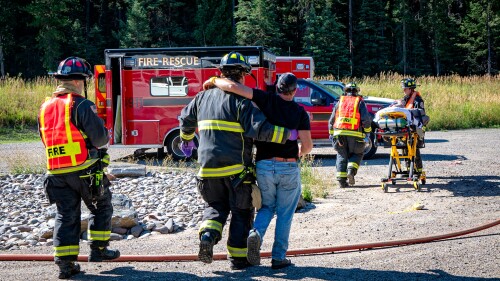The saying “practice makes perfect” is a little misleading. In reality, perfection is rarely, if ever, attainable, no matter how many times you complete a task. In the fire service, rather than aiming for perfection, crews practice and refine their skills every day to achieve as successful a patient outcome as possible.
In Colorado Springs, Colorado, firefighters at the Colorado Springs Fire Department credit a large part of their success to the use of one tool day in and day out – no matter what type of call they encounter. Pulsara, a communication app that’s available on iOS, Android and web browsers, allows members of the department to share patient information with every member of the care team through an intuitive platform.
Using Pulsara daily has allowed those at CSFD to build muscle memory, making emergency management that much easier. Here are 10 specific benefits the department has experienced since the implementation of Pulsara:
1. EFFICIENCY ON EVERY CALL
“The first part is recognizing that this is more than just a communication tool,” said Mark Warth, CSFD fire medical program coordinator. “Most EMS providers are taught that we save lives. The reality is saving lives is rare but what we do save is time. If you look at it in the concept of saving time as opposed to saving lives, saving time not only contributes to saving lives but heart muscle and brain tissue as well.”
Pulsara’s easy-to-use interface helps fire crews enter critical patient information quickly, helping care teams downstream prepare ahead of time.
“If we have a STEMI and we hit the alert, everyone gets notified and the cardiovascular team can review those EKGs immediately,” said Lt. Aaron McConnellogue. “Just having all of those teams notified at the exact same time is the biggest thing we can do to save time.”
2. CONSISTENT PATIENT CARE
Multiple hospitals serve residents of Colorado Springs, where the population is quickly nearing half a million people. That means any one of dozens of doctors could be on the other end of a critical patient call. When CSFD encounters a critical patient, though, they know their physician communication will be consistent. Seven doctors are part of the CSFD team, and the fire crew can contact any one of them via Pulsara for guidance.
“It’s a huge benefit for us that we can talk to our seven physicians within a matter of seconds, even though they might be at the checkout at Walmart,” said McConnellogue. “They’ll be rolling out of bed at home to answer the call through Pulsara.”
3. BETTER TRAINING OUTCOMES
Proficiency in all situations is crucial for first responders, and CSFD uses Pulsara during training exercises to further the skills of each firefighter. The Colorado Springs Municipal Airport is required to conduct mass casualty incident (MCI) training, providing the perfect opportunity to use Pulsara. Recently, the airport recruited 60 actors to take part in a simulated plane crash. In this situation, having used Pulsara already on a daily basis helped make the exercise far easier.
“In MCIs, it’s really difficult to wrap your hands around how many patients you have, who is going to what hospitals, how many are critical and how many are walking wounded or noncritical,” added McConnellogue. “With Pulsara, when we create an incident it tracks all of that information.”
4. PROVEN RELIABILITY
While communicating via radio might bring a greater level of familiarity to fire crews, the chance of transmissions being misunderstood or missed altogether is too great when the clock is ticking. When multiple conversations need to take place between first responders, physicians, hospital staff and countless other members of a care team, the chance of missing information skyrockets.
“Sometimes that information doesn’t get all the way through and it becomes that telephone game of missing information,” said Warth. “Pulsara is an interactive communication tool that’s very objective, with specific data everyone sees in real time.”
Of the many metrics CSFD has tracked since the adoption of Pulsara, perhaps one of the most impressive feats is reducing door-to-surgeon times by seven minutes. Warth says that compared to using the radio, communicating with Pulsara is significantly more reliable.
5. IMMEDIATE PATIENT CARE
Because CSFD uses Pulsara on every call, the department ends up documenting a wide range of emergencies. Not all of them are critical, and even during the instances that are, firefighters can’t always act as urgently as they may want to.
“We’ll get those very challenging patients that don’t want to be transported and they have their justifications, but we know that this is someone having a heart attack and we try to explain to them that there’s a strong possibility they will die if they don’t go to the hospital,” said McConnellogue.
In these situations, the crew uses Pulsara’s consultation feature, allowing them to instantly connect the patient with a physician. McConnellogue says it’s been a huge game changer. “We’ll pull out Pulsara and call the doctor and the doctor will want to be on video to communicate with that patient,” he explained.
6. ENHANCED TEAM COLLABORATION
In addition to working with care providers at hospitals, part of CSFD’s patient care involves the handoff to local EMS. Keeping track of patient data across these groups has further been facilitated by a wristband system that works in conjunction with Pulsara.
“Fire crews can be on scene triaging and there’s no exchange of information that has to take place with our transport provider once they arrive,” explained McConnellogue. “Once they scan the wristband, all the information populates into their Pulsara based off of what fire had, and then they can add to that and select their hospital destinations.”
Stressful scenes make it easy to confuse or omit pertinent patient information which can lead to a delay in care. Since the adoption of Pulsara by both fire and EMS crews in Colorado Springs, the chance of this miscommunication has drastically reduced.
7. REDUCED RATE OF ERROR
Fire crews arriving on scene may not have the luxury of time to ask patients an array of health history questions, but that doesn’t mean they are blind to this need down the line. For every patient that ends up at a hospital, medical history data has to be collected before some types of treatment can begin.
“With a serious medical call, once a patient is in the hospital’s system, they have the ability as soon as that patient hits the door to start ordering lab work, CTs – they can start ordering all of those things because we’ve saved them the time of the actual registration piece by gathering the patient’s demographics within Pulsara,” McConnellogue said.
Gathering this data ahead of time helps reduce the rate of error once a patient arrives at a hospital as staff there will already be aware of any allergies, medication information and more.
8. CALL FLEXIBILITY
Many fire departments have implemented community paramedicine programs which, depending on their scope, might involve elements that differ from more typical emergency calls. Part of the success of these programs depends on accurate documentation, along with the ability to connect patients with additional resources.
By creating a patient channel in Pulsara, first responders can track the types of calls they receive and evaluate trends on a patient-specific or region-specific level. Responders can also help offer more immediate care to those in need of mental health assistance by using the Pulsara app to connect with physicians or social services.
9. EASY UPGRADING
Using one tool consistently compared to a handful of different ones makes it simple for fire departments to identify areas where upgrades are needed, whether it’s a new field within a form or a more streamlined way to access certain features. “Until you put this stuff into practice, you don’t identify its strengths and weaknesses,” said Warth.
CSFD has used Pulsara for many years and has witnessed the platform’s evolution as the company continues to add new features. The introduction of Pulsara’s incident management capabilities gave them the opportunity to put new functionality through its paces and to offer suggestions for continued improvement, which Pulsara has been receptive to, Warth says. While not every suggestion is implemented, Pulsara is committed to continuing to develop the app to best meet customer needs.
10. STREAMLINED INTEGRATION
Most fire departments rely on multiple systems from the moment a call comes to the time they return to the station. As Pulsara has developed over the years, one of the ways the platform has continued to evolve is to integrate with the other tools fire crews regularly use. Early in 2024, Pulsara integrated with ESO’s ePCR solution, which CSFD uses for writing reports. The integration allows responders to pull patient information from Pulsara into their ESO report. Responders can scan the barcode on a patient’s driver’s license with Pulsara, which will automatically populate accurate demographics, such as name, date of birth and gender. That information can then be pulled seamlessly over into ESO.
“What’s big about that is now that ESO integrates with Pulsara, any information we put in via a scan of the driver’s license can’t be messed up from the provider misspelling it. This ensures that the report stays connected, and the hospital receives it without any issues,” said Warth. The integration between the two platforms is helping improve the accuracy of the data from the field, which helps speed up treatment and in turn improves the quality of care patients receive once they arrive at the hospital.
A CONSTANT EVOLUTION
As CSFD continues to use Pulsara every day, new opportunities for improvement will continue to present themselves. “Trying to obtain perfection is very difficult, so we’re trying to be as precise as possible,” said Warth. “If you’re willing to meet challenges and stay aggressive with the progressive movement of information, then your patients will be better for it.”
Visit Pulsara for more information.





